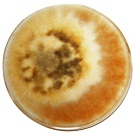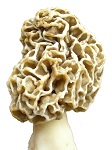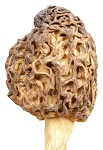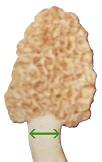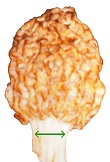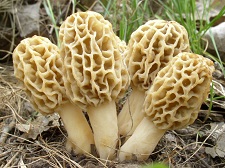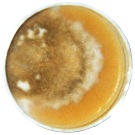 |
|
Research Photo Pages
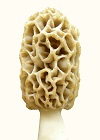
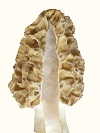
|
The most significant evidence of the morel evolving recently from a yeast is the reversion anomaly, which shows complex differentiation on a surface without the normal structure of the mushroom. Morphology would otherwise be highly stabilized. The anomaly shows tissue structure and pigment on a flat surface of agar gel. To not have a stable morphology means the morel had to evolve recently from an organism which had no macro-morphology — a yeast. Major steps in evolution are generally invisible to science, because they occur so rapidly that even the fossil evidence disappears. To study a major step in evolution as it is occurring is unprecedented in science. The morel produces such a result in a very dramatic way. It is currently evolving from a yeast to a mushroom. This means the macro-morphology (large scale structure) of the morel is evolving from scratch. There is no other known example of macro-morphology originating from a single cell organism in hundreds of millions of years. University scientists assume morels are ancient cup fungi, because the tissue has ascospores embedded within it, as cup fungi always do; and they associate the pits on the surface with the cup shape. Apothecia is the name they use for the cup or pits. But the only relationship is that the cup shape is the convergence point in evolution for fleshy ascomyctes. Fleshy ascomycetes need to evolve toward the cup shape from whatever starting point, because ascospores can only be propelled out of the tissue through a force that results from shrinkage upon drying. The cup shape promotes that result. It does so by providing a flat shape and a rim which extends into the air for drying. But such mushrooms also need to delay drying to allow spores to form. The morel requires about three to five days for spores to mature. To delay drying, some of the tissue needs to be thick and sheltered. The bottom of the cup has those characteristics, and it even allows some water to accumulate. With this shape, there are extreme areas which delay and promote drying. Therefore, whatever the weather conditions, there is some place on the cap where drying occurs at the right rate for creating spores.
The cup shape is starting to form on some morels as an indent near the top but off to the side. The indent is most pronounced with the round shape, and it is barely visible with the cone or cylindrical shapes. Each local strain of morels includes the standard variety of shapes plus various pigments. The standard shapes are cone, cylinder and round with gradations in between. Also, each of these comes in thin tissue or thick tissue. All of these variations are found together wherever morels come up. Here are a variety of morels that grew near each other.
These variations are phenotypic but not genotypic. This means that each type is genetically the same, while appearance is different. The mechanism is similar to embryo development, where each cell has the same genes, but different tissues form. This result is possible, because some genes are turned on, while others are turned off. The phenotype photo page shows the source of these variations very clearly. My results show that morels evolved from a yeast very recently, which means about 20 thousand years ago. As a result, the physiology of morels is still yeast-like, and the morphology is unstable. The instability shows up in two dramatic ways. One is an anomaly which forms under laboratory conditions when nutrition is adequately controlled. The other major example is abnormal morphology when morels are grown by the Ower procedure. The appearance is sometimes like balloons with a smooth surface. There are no other known species which undergo such exreme morphological aberrations. The strange formations occur for the morel because it evolved so recently from a species which had no complex morphology that it has not yet stabilized its morphology.
Another morphological trait of morels is that they do not measure gravity for growing vertical. Whatever direction they start growing as they emerge from the soil is the direction which they keep growing. Almost everything which emerges from the soil measures gravity for vertical growth. The inability of the morel to measure gravity is additional evidence of its very recent evolution from an organism without macromorphology. This photograph shows the effect.
The anomaly looks like a pretty, colored, fuzzy growth of mycelium. Mushrooms do not form a pretty, colored, fuzzy mycelium. The mycelium is never pigmented, because it grows underground, where there is no light. The anomaly is a reversion to an earlier evolutionary form, where a yeast growing on sap at the base of trees evolved into the morel. As the mycelium reverts to the earlier form under laboratory conditions, it scrambles its characteristics. See Anomaly Explained
I show a variety of pretty anomalies on the anomaly photo page. Phenotypic variation is shown on the Phenotypte Photo Page. See also: a ridiculous phylogenetic study
|
